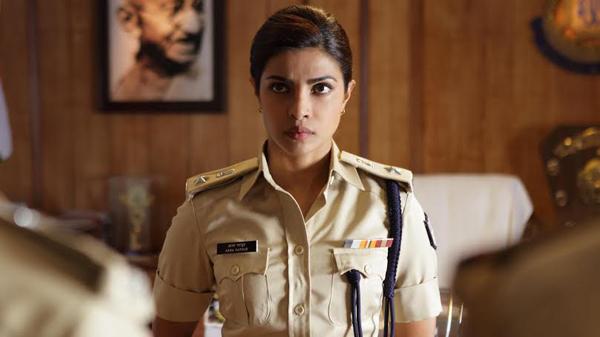 images
images
The law-keepers on screen
Prakash Jhas Jai Gangaajal sees Priyanka Chopra, currently much in news, as a high-ranking police officer. While finding her depiction rather unconvincing, Shoma A. Chatterji tries to look more critically at the men and women in police force as portrayed in Hindi cinema
The uniform of the policeman is a structured image and one can easily relate to in daily life. In Hindi cinema, it more or less duplicates the policeman or woman that image. Add to it some glamour, or notoriety, as the case maybe, and a magnified image reaches the audience in a larger canvas.
Saying that, popular cinema often fails to portray the law-keeper in the proper prospective. Take Prakash Jha’s Jai Gangaajal . Priyanka Chopra, known for her commitment to roles, plays a high-ranking police officer. But the star image and charisma of one of the best actresses in Bollywood is spoilt by that image itself and what we see on screen is a Chopra carefully made-up to emphasise a hard jaw line and the obligatory uniform tailored to stress her chiselled figure.
Sometimes the portrayal brings in changes in public perception. Zanjeer changed the face of the mainstream cop in the 70s. For the first time, the angry young man Vijay (Amitabh) in police uniform strode across the screen, holding the audience in thrall with his unsmiling visage, eager-to-hit fists and used cuss language , a novel thing at the time. Inspector’s methods were unorthodox, both within the police force, as well as against the backdrop of Hindi cinema’s policeman stereotype, and thus made history. It was followed by screen images where the honest policeman often threw away his badge, uniform and slugged his rifle on the shoulder to fight the criminals outside the law when he failed to do this within the system.
Govind Nihalani through Ardh Satya presented Anant Velankar in a film that potrayed with scathing contempt, the police-criminal nexus for the first time. “Anant Velankar could arguably emerge as the most significant character of the ‘80s because he symbolises the brutalisation of an essentially sensitive man,” writes critic Maithili Rao.
The angry young cop with distinct, negative traits such as drinking and womanising to a fault, was articulate in Satyameva Jayate featuring Vinod Khanna as the policeman. The cop in this film is angry, brutal, violent, on the edge of disillusionment for his loss of faith in the goodness of human beings. This trend continued through films like Akeyla and Mujrim down to Pratibandh said to have been inspired the LTTE militants with the modus operandi for the assassination of Rajiv Gandhi in 1991.
Through 2000 and beyond, policemen have played important roles in many films placing the police force or a single policeman at the centre of the script mainly as perpetrators of violence, reflective of the drama in real life. Examples are – Ab Tak Chappan, Shoot Out at Lokhandwalla, Kurukshetra, Sarfarosh, Dus, Dev, Khakee etc..jpg)
Prakash Jha’s Apaharan and previous Gangaajal and E. Niwas’s Shool have taught us, sometimes even at the suggestive level, the downside of the service such as shortage of personnel, wages of policemen, corruption with the political nexus, decay in the force’s rank and file and betrayal by the upper echelons where it is either difficult or impossible for an honest policeman to survive let alone rise professionally in the force. In Mumbai alone, the ratio between police and citizens is 2.6 to 1000 which most likely is worse elsewhere in the country.
The policeman became a true entertainer a la Salman Khan as Chulbul Pandey in Dabangg and its sequel. Dabangg released in September 2010, became the highest opener of all time across India.Chulbul Pandey in all his crude loudness, his exaggeratedly stylised performance, his pelvis shaking dance numbers with overtly sexual innuendo, his corrupt ways has turned the celluloid policeman on its head in a film that is otherwise spilling over with some of the most gross, gory and bloody scenes of violence seen in recent times. Pandey is fleshed out as a larger-than-life hero who wears his uniform complimented with his RayBan glassed in great style yet gets wobbly at the knees when he meets the beautiful but strict Rajo. It is still violence where the policeman hero is both perpetrator and victim.
In some recent Bollywood films, we witness the emergence of the woman as a police officer, desperate to be as gritty, as ruthless and as ready to indulge in violent strategies as men, or may be, a bit more. The policewoman in uniform has appeared rarely in films bent of woman as the avenging angel such as Dimple Kapadia in Zakhmi Aurat which was a strong patriarchal statement that claimed that a policewoman was as vulnerable to rape as any ordinary woman on the street.
In Khalnayak, Ganga, the police inspector played by Madhuri Dixit is a classic example of how the woman-police-officer image offers a host of visual variants on the sex appeal of the woman’s body. It helps manipulate cinematically, a power-reversal symbolised by the different way of cross-dressing in male clothes. The screenplay plays on the sensual and box office image of Madhuri Dixit by writing in her disguise as a nautanki dancer and even performing an item number to save her top officer fiancé Ram’s face! That is where her ‘empowerment’ begins and ends.
Mardaani has a larger agenda gained through individual fights between one man and one woman in a tussle in who will win. But in the larger context, Shivani (Rani Mukherji), the police officer nails down the kingpin of child trafficking by having him killed by his own victims. The aggression and the violence is built up slowly that underlines the credibility of the revenge that spells out professional ethics, excellence of execution and resolution of a seemingly impossible national problem.
Dhrishyam opens a new window to world of women in police uniform in Bollywood. The clash is not only between the hunter – the IGP Meera Deshmukh (Tabu) and the hunted, Vijay Salgaonkar but also between Meera the IGP and Meera the mother. If you read between the lines in one of Tabu’s best performances, the conflict between the policewoman and the mother is more intense that takes a toll on the responsibility of Deshpande as police top brass. Does the designation inthe uniform empower her? Not really because the mother overshadows the police chief and the chief resigns before she is dismissed.
Top Headlines
-
Entertainment
Valentyn Vasyanovychs To The Victory! wins 2025 TIFF Platform Award unanimously
September 26, 2025
-
Entertainment
Chlo Zhaos Hamnet Wins TIFF 2025 Peoples Choice Award
September 20, 2025
-
Entertainment
Sholay: Golden even after fifty years
July 04, 2025
-
Entertainment
War 2: Check out Hrithik Roshan, Jr NTR and Kiara Advani's new posters
June 26, 2025
-
Entertainment
LGBTQIA+: Icelandic film Odd Fish and Brazil's Baby win big at KASHISH 2025 film festival
June 12, 2025
-
Entertainment
Katrina Kaif named Maldives tourism global brand ambassador ahead of Modi's visit
June 10, 2025
-
Entertainment
'Queen marches to conquer': Deepika Padukone joins Atlee's AA22xA6 starring Allu Arjun after 'Spirit' exit
June 08, 2025
-
Entertainment
Dakota Johnson and Chris Martin, who were in on-and-off relationship, broke up: Reports
June 06, 2025
-
Entertainment
Sharmila Tagore to Alia Bhatt, India weaves cross-generational tale at Cannes 2025
May 28, 2025
-
Entertainment
Is Sandeep Reddy Vanga's cryptic 'feminism' post meant for Deepika Padukone? Neitzens think so
May 27, 2025


